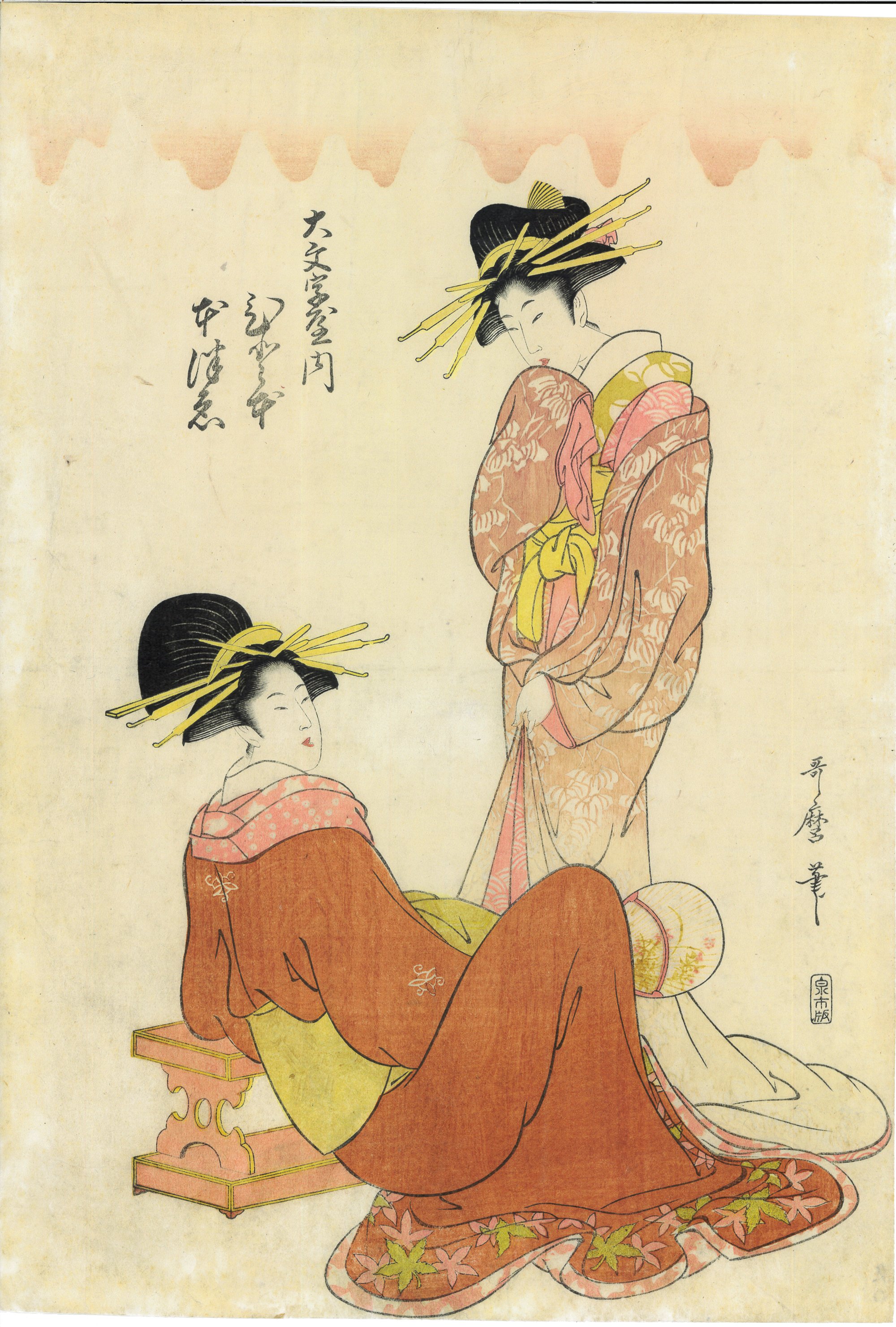Utamaro | Courtesans Hotomoto and Mototsue from Daimonjiy
喜多川歌麿 Kitagawa Utamaro (1753-1806)
大文字屋内 一本 本津枝
Courtesans Hotomoto and Mototsue from Daimonjiy
1802
木版画 | 纵绘大判 | 37cm x 25.5cm
Woodblock-print | Oban tate -e | 37cm x 25.5cm
颜色保存非常好;早期版次;品相非常好
Great colour and condition, early impression
SOLD
大文字屋,一个时常出现在艺伎主题浮世绘中,人们却对其所知甚少的名字。地处新吉原京町一丁目的它,曾是江户城内首屈一指的青楼。百余年间,数不尽的文人骚客、艺者玩家日夜聚集于此,在一场接一场的古早“文艺沙龙”中,探讨品评着俳句、插花、香道、书法与丹青。天性好玩乐的“青楼画家”歌麿自然也是大文字屋中的常客。面对着屋中两位色艺双绝的花魁,他更是毫不吝惜自己的笔墨。在本作中,歌麿没有以自己最擅长的“大首绘”或半身像构图,而是选用了更为传统的全身像作画。发插玳瑁簪笄的一本与本津枝皆是典型的“歌麿式”开脸,成熟而不失纤细,一立姿一倚姿,自然地形成了平衡和谐的画面结构。衣装则以绯红为主色调,搭配藤蔓秋叶纹饰,温暖柔软,洁净雅致。全画背景无任何装饰,仅有最上方一行如蜡泪状的薄红点缀,正如丝丝暧昧的气息,自空中缓缓滑落。
Interested in purchasing?
Please contact us.
喜多川歌麿 Kitagawa Utamaro (1753-1806)
大文字屋内 一本 本津枝
Courtesans Hotomoto and Mototsue from Daimonjiy
1802
木版画 | 纵绘大判 | 37cm x 25.5cm
Woodblock-print | Oban tate -e | 37cm x 25.5cm
颜色保存非常好;早期版次;品相非常好
Great colour and condition, early impression
SOLD
大文字屋,一个时常出现在艺伎主题浮世绘中,人们却对其所知甚少的名字。地处新吉原京町一丁目的它,曾是江户城内首屈一指的青楼。百余年间,数不尽的文人骚客、艺者玩家日夜聚集于此,在一场接一场的古早“文艺沙龙”中,探讨品评着俳句、插花、香道、书法与丹青。天性好玩乐的“青楼画家”歌麿自然也是大文字屋中的常客。面对着屋中两位色艺双绝的花魁,他更是毫不吝惜自己的笔墨。在本作中,歌麿没有以自己最擅长的“大首绘”或半身像构图,而是选用了更为传统的全身像作画。发插玳瑁簪笄的一本与本津枝皆是典型的“歌麿式”开脸,成熟而不失纤细,一立姿一倚姿,自然地形成了平衡和谐的画面结构。衣装则以绯红为主色调,搭配藤蔓秋叶纹饰,温暖柔软,洁净雅致。全画背景无任何装饰,仅有最上方一行如蜡泪状的薄红点缀,正如丝丝暧昧的气息,自空中缓缓滑落。
Interested in purchasing?
Please contact us.
喜多川歌麿 Kitagawa Utamaro (1753-1806)
大文字屋内 一本 本津枝
Courtesans Hotomoto and Mototsue from Daimonjiy
1802
木版画 | 纵绘大判 | 37cm x 25.5cm
Woodblock-print | Oban tate -e | 37cm x 25.5cm
颜色保存非常好;早期版次;品相非常好
Great colour and condition, early impression
SOLD
大文字屋,一个时常出现在艺伎主题浮世绘中,人们却对其所知甚少的名字。地处新吉原京町一丁目的它,曾是江户城内首屈一指的青楼。百余年间,数不尽的文人骚客、艺者玩家日夜聚集于此,在一场接一场的古早“文艺沙龙”中,探讨品评着俳句、插花、香道、书法与丹青。天性好玩乐的“青楼画家”歌麿自然也是大文字屋中的常客。面对着屋中两位色艺双绝的花魁,他更是毫不吝惜自己的笔墨。在本作中,歌麿没有以自己最擅长的“大首绘”或半身像构图,而是选用了更为传统的全身像作画。发插玳瑁簪笄的一本与本津枝皆是典型的“歌麿式”开脸,成熟而不失纤细,一立姿一倚姿,自然地形成了平衡和谐的画面结构。衣装则以绯红为主色调,搭配藤蔓秋叶纹饰,温暖柔软,洁净雅致。全画背景无任何装饰,仅有最上方一行如蜡泪状的薄红点缀,正如丝丝暧昧的气息,自空中缓缓滑落。
Interested in purchasing?
Please contact us.
Kitagawa Utamaro (1753-1806)
Is there a line more elegant, more evocative, more sensual than the subtle curve that magically evokes the face or figure of a beautiful woman as drawn by Kitagawa Utamaro?
She can be a concubine or a mother or anything in between, in an elaborate kimono or a casual yukata with a glimpse of exposed breast, yet in this master’s hands, her every emotion and mood is captured with a smooth simplicity never equaled.
In all of Ukiyoe, Utamaro was the undisputed master of the beautiful woman -- or bijin -- print, and his works in and of themselves constitute a golden age of the Japanese woodblock art. He was born in 1753, just as the form came into its own, and died in 1806.
He first produced actor prints in the style of Shunsho, but quickly adjusted his focus to beautiful women in the style of Kiyonaga. He mastered both face and full-figure portraits – always slender and graceful -- and showed a sly talent for erotic prints: his are often sexy without being overly explicate. He also produced dozens of books and was something of a lively character in the great Edo social whirl of those days, known around town for his personality, joie de vivre and charm as much as for his talent.
In all he worked with about 60 publishers. He could capture a woman’s complex emotions simply by the angle of her almond-shaped eyes or the ripe shape of her slightly parsed lips. So many of these women seem as if from a dream, and as if they are lost in their own dreams; they appear to be simultaneously of this world and from another one that we mere mortals cannot begin to imagine.
And whereas sometimes having small children in Ukiyoe brings down a design’s value, in the case of Utamaro, who produced many, many prints of mothers and children, the opposite seems to be true.
He established his own school. In due time, as Ukiyoe became more and more colorful and, perhaps, decadent, Utamaro fell from favor. Late in his life he was briefly imprisoned for a print depicting the Hideyoshi Shogun with courtesans.
But his reputation grew to spectacular heights as the West discovered Japanese woodblock prints in the late 1800s and early 1900s.
Partial citation: Highly Important Japanese Prints, Illustrated Books and Drawings, from the HENRI VEVER Collection: Part 1 (Sotheby & Co.; 1974). Marks, Andreas, Japanese Woodblock Prints, Artists, Publishers and Masterworks: 1680-1900 (Tuttle; 2010).


